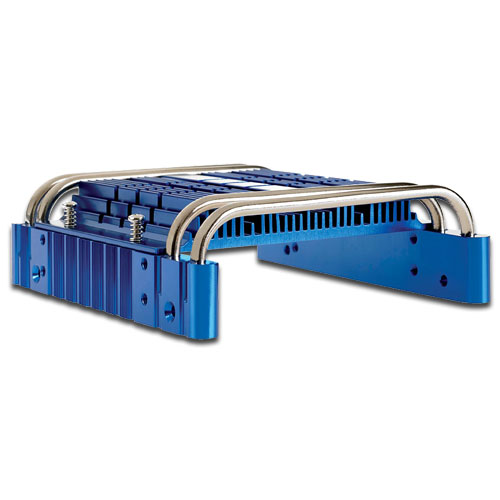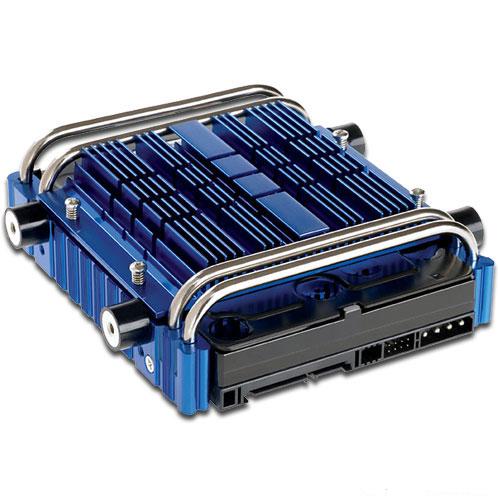Specifications
The ULT40010 is a passive 3.5" hard drive cooler. The unit is an attractive blue aluminum, bristling with cooling fins along the top of the cooler itself. Heat pipes run along the front and rear of the unit, providing an additional boost in thermal transfer capability. Four rubber spacers screw into the unit and act as mounting points for the chassis screws. Ultra has chosen to include a grounding wire with the ULT40010, which is a sensible precaution given that the aforementioned spacers are the primary contact point with the case.

Installation of the ULT40010 is simple, aided by an eight-step illustration supplied in the packaging. The hard drive mounts underneath the cooler, with the top of the drive flush against the cooler's heat transfer plate. Screws pass through the cooler and into the standard mounting holes on the sides of the hard drive. The four rubber dampers screw into the cooler's side, in either an upper or a lower position, to accommodate the style of case that will house the cooler. There are four spring-loaded screws on the top of the ULT40010 that ensure that the cooler's heat transfer plate is firmly pushed up against the top of the hard drive casing; this will ensure maximum surface area contact and thus heat dissipation. The cooler does not use thermal paste, so this is an important consideration.

The Ultra cooler installs into a free 5.25" bay in a standard PC case. While removing the front panel isn't necessary, we found it substantially easier to install the assembled cooler from the front of the case, rather than trying to insert it from inside the case cavity. Once the cooler is in place, screws go through the PC case's mounting holes and into a screw hole in the center of the rubber dampers. This results in only rubber mounts touching the PC case, and this helps to lessen drive vibration compared to a standard metal-on-metal mount configuration. Attaching the included grounding strap to a drive mount hole on the PC case completes the installation process.
| Ultra ULT40010 Hard Drive Cooler | |
| Heatpipe Material | Sintered Powder Heatpipe |
| Heatsink Material | Aluminum |
| Grounding | Wire Grounding |
| Dimensions | 143 x 122 x 42mm |
| Weight | 402g |
| . | |
The ULT40010 is a passive 3.5" hard drive cooler. The unit is an attractive blue aluminum, bristling with cooling fins along the top of the cooler itself. Heat pipes run along the front and rear of the unit, providing an additional boost in thermal transfer capability. Four rubber spacers screw into the unit and act as mounting points for the chassis screws. Ultra has chosen to include a grounding wire with the ULT40010, which is a sensible precaution given that the aforementioned spacers are the primary contact point with the case.

Installation of the ULT40010 is simple, aided by an eight-step illustration supplied in the packaging. The hard drive mounts underneath the cooler, with the top of the drive flush against the cooler's heat transfer plate. Screws pass through the cooler and into the standard mounting holes on the sides of the hard drive. The four rubber dampers screw into the cooler's side, in either an upper or a lower position, to accommodate the style of case that will house the cooler. There are four spring-loaded screws on the top of the ULT40010 that ensure that the cooler's heat transfer plate is firmly pushed up against the top of the hard drive casing; this will ensure maximum surface area contact and thus heat dissipation. The cooler does not use thermal paste, so this is an important consideration.

The Ultra cooler installs into a free 5.25" bay in a standard PC case. While removing the front panel isn't necessary, we found it substantially easier to install the assembled cooler from the front of the case, rather than trying to insert it from inside the case cavity. Once the cooler is in place, screws go through the PC case's mounting holes and into a screw hole in the center of the rubber dampers. This results in only rubber mounts touching the PC case, and this helps to lessen drive vibration compared to a standard metal-on-metal mount configuration. Attaching the included grounding strap to a drive mount hole on the PC case completes the installation process.










31 Comments
View All Comments
mindless1 - Monday, November 5, 2007 - link
What is sweet about a totally passive system?Even a barely turning fan will reduce temps a LOT, it can easily be inaudible, fan can easily last for 20 years, and will reduce system cost by quite a lot while increasing lifespan by quite a lot. It's also a lot easier too, there are very few situations where avoiding fans is a good idea, it's mostly a marketing gimmick made into an urban myth by companies who use a higher RPM fan than really needed so they can save a buck using a smaller or less elaborate heatsinking. IOW, you can have the best of both worlds, need not go to either extreme.
Dave Robinet - Saturday, November 3, 2007 - link
Nope - no thermal paste. The device pushes against the hard drive using the spring-loaded screws.Michael91ah - Friday, November 2, 2007 - link
I use a setup much like these and really did notice a marked decrease in noise levels. The case intake fan blows right across them which prolly isn't such a good idea now that I think about it.Dave Robinet - Friday, November 2, 2007 - link
We've added a couple of hard drives in the graph for comparison purposes. If you go to the test results page and refresh, you'll see the updated data.Thanks for the suggestions, everyone!
Calin - Friday, November 2, 2007 - link
The cooling is better with a hot drive - but overall, it doesn't make such a big differenceTiamat - Friday, November 2, 2007 - link
Zalman ZM-2HC1/2 for example. I wonder how they compare...michal1980 - Friday, November 2, 2007 - link
whats the NEED to cool your harddrive?is there any spec that says running at a normal temprature will hurt the drive?
take the 40 bucks and buy a better drive... or bigger.
Slaimus - Friday, November 2, 2007 - link
The older Maxtor DiamonsMax 9/10/11 series ran really hot and failed early if not properly cooled. Before that, the IBM 75GXP deathstars also lasted much longer when actively cooled.magreen - Friday, November 2, 2007 - link
That was my big question I hoped the article would address - does a hdd ever actutually need cooling?Calin - Friday, November 2, 2007 - link
If you manage to cool your hard drive 10 or more degrees Celsius (15+ Fahrenheit), then this device would be a good thing - but you need a situation where the hard drive gets much warmer than the 35 or so of testing.